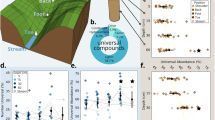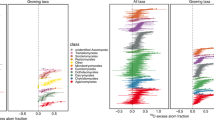Abstract
Temperate and tropical rivers serve as a significant source of carbon dioxide to the atmosphere1,2,3,4. However, the source of the organic matter that fuels these globally relevant emissions is uncertain. Lignin and cellulose are the most abundant macromolecules in the terrestrial biosphere5, but are assumed to resist degradation on release from soils to aquatic settings6,7,8. Here, we present evidence for the degradation of lignin and associated macromolecules in the Amazon River. We monitored the degradation of a vast suite of terrestrially derived macromolecules and their breakdown products in water sampled from the mouth of the river throughout the course of a year, using gas chromatography time-of-flight mass spectrometry. We identified a number of lignin phenols, together with 95 phenolic compounds, largely derived from terrestrial macromolecules. Lignin, together with numerous phenolic compounds, disappeared from our analytical window following several days of incubation at ambient river temperatures, indicative of biological degradation. We estimate that the net rate of degradation observed corresponds to 30–50% of bulk river respiration. Assuming that a significant fraction of these compounds is eventually remineralized to carbon dioxide, we suggest that lignin and other terrestrially derived macromolecules contribute significantly to carbon dioxide outgassing from inland waters.
This is a preview of subscription content, access via your institution
Access options
Subscribe to this journal
Receive 12 print issues and online access
$259.00 per year
only $21.58 per issue
Buy this article
- Purchase on Springer Link
- Instant access to full article PDF
Prices may be subject to local taxes which are calculated during checkout



Similar content being viewed by others
References
Cole, J. J., Caraco, N. F., Kling, G. W. & Kratz, T. K. Carbon dioxide supersaturation in the surface waters of lakes. Science 265, 1568–1570 (1994).
Richey, J. E., Melack, J. M., Aufdenkampe, A. K., Ballester, V. M. & Hess, L. L. Outgassing from Amazonian rivers and wetlands as a large tropical source of atmospheric CO2 . Nature 416, 617–620 (2002).
Duarte, C. & Prairie, Y. Prevalence of heterotrophy and atmospheric CO2 emissions from aquatic ecosystems. Ecosystems 8, 862–870 (2005).
Butman, D. & Raymond, P. Significant efflux of carbon dioxide from streams and rivers in the United States. Nature Geosci. 4, 839–842 (2011).
Boerjan, W., Ralph, J. & Baucher, M. Lignin biosynthesis. Ann. Rev. Plant Biol. 54, 519–546 (2003).
Hedges, J., Clark, W. & Cowie, G. Fluxes and reactivities of organic-matter in a coastal marine bay. Limnol. Oceanograph. 33, 1137–1152 (1988).
Gough, M., Fauzi, R., Mantoura, C. & Preston, M. Terrestrial plant biopolymers in marine sediments. Geochim. Cosmochim. Acta 57, 945–964 (1993).
Opsahl, S. & Benner, R. Distribution and cycling of terrigenous dissolved organic matter in the ocean. Nature 386, 480–482 (1997).
Battin, T. et al. Biophysical controls on organic carbon fluxes in fluvial networks. Nature Geosci. 1, 95–100 (2008).
Tranvik, L. et al. Lakes and reservoirs as regulators of carbon cycling and climate. Limnol. Oceanograph. 54, 2298–2314 (2009).
Canadell, J. et al. Factoring out natural and indirect human effects on terrestrial carbon sources and sinks. Environ. Sci. Policy 10, 370–384 (2007).
Field, C., Behrenfeld, M., Randerson, J. & Falkowski, P. Primary production of the biosphere: Integrating terrestrial and oceanic components. Science 281, 237–240 (1998).
Malhi, Y. et al. Climate change, deforestation, and the fate of the Amazon. Science 319, 169–172 (2008).
Mayorga, E. et al. Young organic matter as a source of carbon dioxide outgassing from Amazonian rivers. Nature 436, 538–541 (2005).
Rodrı´guez-Zúñiga, U. F. et al. Changes in optical properties caused by ultraviolet-irradiation of aquatic humic substances from the Amazon River Basin: Seasonal variability evaluation. Environ. Sci. Technol. 42, 1948–1953 (2008).
Spencer, R. G. M. et al. Photochemical degradation of dissolved organic matter and dissolved lignin phenols from the Congo River. J. Geophys. Res. 114, G03010 (2009).
Remington, S., Krusche, A. V. & Richey, J. E. Effects of DOM photochemistry on bacterial metabolism and CO2 evasion during falling water in a humic and a whitewater river in the Brazilian Amazon. Biogeochemistry 105, 185–200 (2011).
Schmidt, M. W. I. et al. Persistence of soil organic matter as an ecosystem property. Nature 478, 49–56 (2011).
Paterson, A. & Lundquist, K. Radical breakdown of lignin. Nature 316, 575–576 (1985).
Feng, X. J. et al. Increased cuticular carbon sequestration and lignin oxidation in response to soil warming. Nature Geosci. 1, 836–839 (2008).
Bose, S. K. et al. Lignin content versus syringyl to guaiacyl ratio amongst poplars. Biores. Technol. 100, 1628–1633 (2009).
Martens, D., Reedy, T. & Lewis, D. Soil organic carbon content and composition of 130-year crop, pasture and forest land-use managements. Glob. Change Biol. 10, 65–78 (2004).
Keil, R. & Neibauer, J. Analysis of cooking spices in natural waters. Limnol. Oceanograph. Methods 7, 848–855 (2009).
Goni, M. A. & Montgomery, S. Alkaline CuO oxidation with a microwave digestion system: Lignin analyses of geochemical samples. Anal. Chem. 72, 3116–3121 (2000).
Koch, B. P. & Dittmar, T. From mass to structure: An aromaticity index for high-resolution mass data of natural organic matter. Rapid Commun. Mass Spectrom. 20, 926–932 (2006).
Benner, R., Opsahl, S., ChinLeo, G., Richey, J. & Forsberg, B. Bacterial carbon metabolism in the Amazon River system. Limnol. Oceanogr. 40, 1262–1270 (1995).
Ellis, E. E., Keil, R. G., Ingalls, A. E. & Richey, J. E. Seasonal variability in the sources of particulate organic matter of the Mekong River as discerned by elemental and lignin analyses. J. Geophys. Res. 117, G01038 (2012).
Ward, N., Richey, J. & Keil, R. Temporal variation in river nutrient and dissolved lignin phenol concentrations and the impact of storm events on nutrient loading to Hood Canal, WA, USA. Biogeochemistry 111, 629–645 (2012).
Hedges, J., Blanchette, R., Weliky, K. & Devol, A. Effects of fungal degradation on the CuO oxidation-products of lignin—a controlled laboratory study. Geochim. Cosmochim. Acta 52, 2717–2726 (1988).
Houghton, R., Lawrence, K., Hackler, J. & Brown, The spatial distribution of forest biomass in the Brazilian Amazon: A comparison of estimates. Glob. Change Biol. 7, 731–746 (2001).
Acknowledgements
Financial support was provided by the Gordon and Betty Moore Foundation Marine Microbial Initiative for the River-Ocean Continuum of the Amazon project (Lead PI: P.L.Y.), NSF, and FAPESP Grant #08/58089-9. Lignin analyses were performed in the UW Aquatic Organic Geochemistry Laboratory with assistance from B. Kimball, J. Neibauer and A. Townsend. Sampling in Macapá was assisted by students J. E. Melo Diniz, K. dos Santos, E. Santos, B. Zelinsky, C. Smith, B. Satinsky and C, Fortunato. Bacterial abundance counts were made by A. MacDougall at the University of Georgia. Sampling in Óbidos was assisted by J. Mauro, T. Beldini and R. da Silva.
Author information
Authors and Affiliations
Contributions
P.M.M. and T.D. performed ESI–FT–ICR–MS analyses and data interpretation. D.C.B. and A.C.C. measured bulk respiration rates and organized Macapá sampling logistics. A.V.K. measured DOC concentrations and oversaw and organized all Amazon River sampling logistics. P.L.Y. measured bacterial abundance and coordinated the River-Ocean Continuum of the Amazon project. J.E.R. calculated discharge rates and managed field logistics. N.D.W. and R.G.K. designed the study, performed all lignin and GC–ToF–MS analyses, and wrote the manuscript. All authors discussed the results and commented on the manuscript.
Corresponding author
Ethics declarations
Competing interests
The authors declare no competing financial interests.
Supplementary information
Supplementary Information
Supplementary Information (PDF 792 kb)
Rights and permissions
About this article
Cite this article
Ward, N., Keil, R., Medeiros, P. et al. Degradation of terrestrially derived macromolecules in the Amazon River. Nature Geosci 6, 530–533 (2013). https://doi.org/10.1038/ngeo1817
Received:
Accepted:
Published:
Issue Date:
DOI: https://doi.org/10.1038/ngeo1817
This article is cited by
-
The origin of suspended particulate matter in the Great Barrier Reef
Nature Communications (2023)
-
Photo-produced aromatic compounds stimulate microbial degradation of dissolved organic carbon in thermokarst lakes
Nature Communications (2023)
-
Contribution of riverine dissolved organic carbon to organic carbon decomposition in the Ariake Sea, Japan, a coastal area suffering from summer hypoxia
Aquatic Sciences (2023)
-
Vulnerability of biological resources to potential oil spills in the Lower Amazon River, Amapá, Brazil
Environmental Science and Pollution Research (2022)
-
Collateral implications of carbon and metal pollution on carbon dioxide emission at land-water interface of the Ganga River
Environmental Science and Pollution Research (2022)



